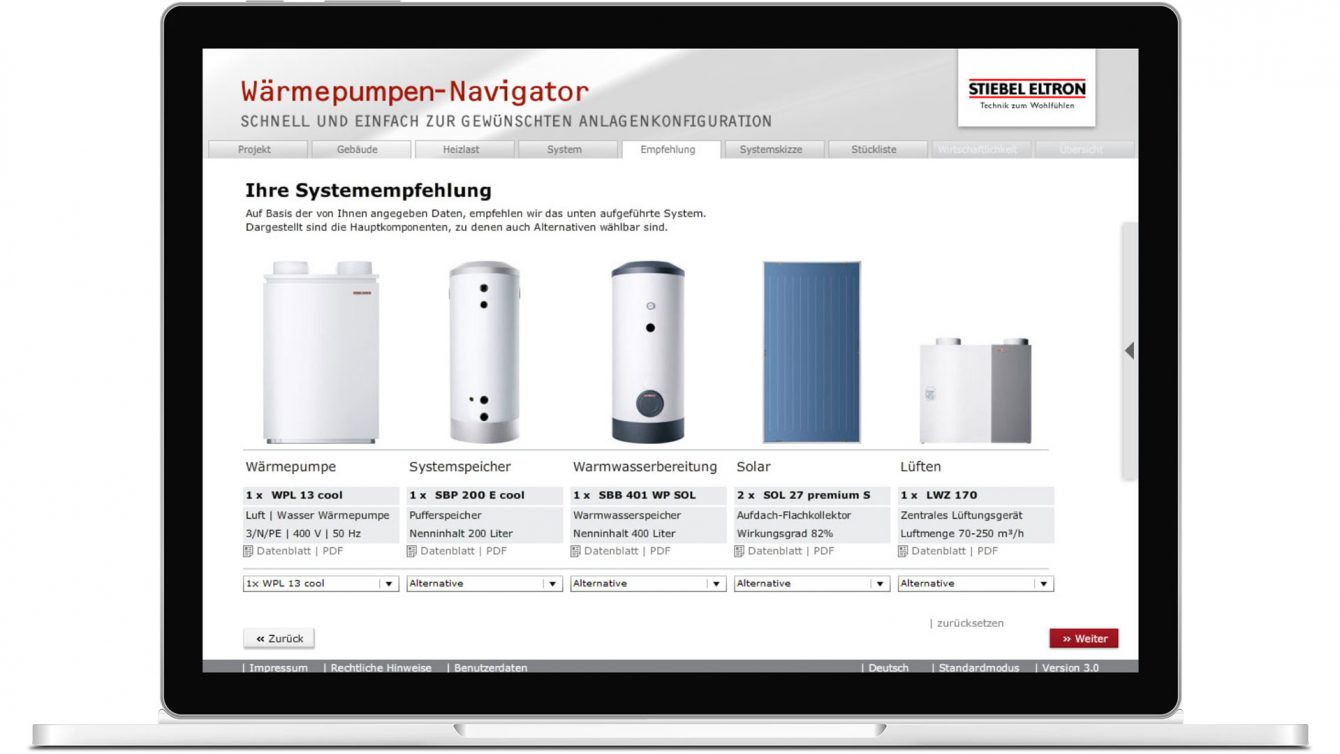Stiebel Eltron Navigator heat pumps
Design program for heat pump systems

About the project
The family company Stiebel Eltron, based in Holzminden, is one of the leading manufacturers in the field of house and system technology.
Task:
Development of a design program for the area of heat pumps in order to effectively design the daily planning of heat pump systems.
Realization:
The heat pump navigator is an important planning tool for specialists for designing heat pump systems.
Despite the ever increasing complexity of technical relationships, the application continues to be self-explanatory and user-friendly.
The heat pump navigator has been used in numerous European countries for several years, where the respective country-specific requirements have been taken into account.
The heat pump navigator is divided into a standard and expert mode. In standard mode, the user is guided through the planning, the best possible system solution is determined depending on climate data, building data and building services functions such as cooling, ventilation and solar. The user can further modify the solution by choosing from a selection of further alternative suggestions.
CONFIGURATION OF THE BUILDING
The building data are the basis for the heat pump design. The heat requirement of the building is determined by living space, room height and type of building. Different building types can be configured taking into account the energy saving regulation. Carried out renovation measures are also calculated.
DETERMINATION OF THE HEATING LOAD
The heating load is the essential parameter when planning a heat pump system.
Therefore, three options for determining the heating load are available in the heat pump navigator:
- Direct input of the heating load
- Input of the specific heat requirement
- Input of known consumption (oil, gas, liquid gas or electricity)
PLANNING PLANTS
The heat pump navigator comprises an extensive range of heat pumps of various designs. In the first step, the number of solutions is therefore minimized by selecting the desired heat source and installation. When selecting the control elements, the heat pump navigator graphically displays the selected options in a system house. This way, the user is immediately presented with the differences in the technical possibilities.
PLANNING HOUSE TECHNOLOGY FUNCTIONS
Once the performance and type of possible heat pumps have been determined, the user will be presented with other combinable building technology functions. The heat pump navigator offers functions such as cooling, ventilation and solar thermal to economically optimize the system house. The building services functions are also shown graphically in the system house.
SYSTEM RECOMMENDATION
As a result, the optimal solution for the heat pump system is determined. In addition, the user can choose possible alternative solutions. In the case of selected building services functions such as ventilation or solar thermal, these components can be specified even further.
HYDRAULIC AND ELECTRICAL WIRING DIAGRAM
Hydraulics and electrical circuit diagrams are essential when planning the heat pump system. The heat pump navigator contains over 2,000 circuit diagrams in high resolution, the plans can be zoomed in 3 steps, every small detail is clearly recognizable for the skilled worker. All plans can also be saved as a PDF file.
PROFITABILITY ANALYSIS
The plant planning is rounded off by a meaningful economic analysis. Investment and consumption costs for the planned heat pump system are determined and compared with conventional heating systems (gas, oil). Finally, the amortization (table and diagram) shows the expected economic success. The heat pump navigator thus provides the tradesman with important arguments in a sales discussion with his end customer.
PLANT DESIGN IN EXPERT MODE
The experienced specialist plans in expert mode.
In the heat pump navigator, the expert can plan and evaluate his system depending on building data, outside temperature and flow temperature. Heating load and heat pump output are shown in a diagram as curves. This representation enables the expert to evaluate the behavior of the system under various conditions. When changing the conditions such as outside temperature and flow temperature, the curve displays are immediately recalculated and displayed. The result shows the bivalence point and the degree of coverage of the heat pump, both of which are essential factors in order to be able to compare several systems with each other.
EVALUATION OF THE HEAT PUMP SYSTEM
In a direct comparison between different heat pumps, the expert planner can assess which heat pump is best suited for his system. The heat pump navigator supports him with the graphical representation of the heat pump output, heating load and output of the equivalence point.
MATERIAL AND ORDER LIST
In addition to the main product groups of heat pumps, buffer tanks, hot water tanks, all the necessary accessories for installing the system appear in the parts list. The material list is logically grouped and provides a clear overview of the overall system.
In the order list, the user can add more articles from the extensive product database or delete existing articles from the order list.